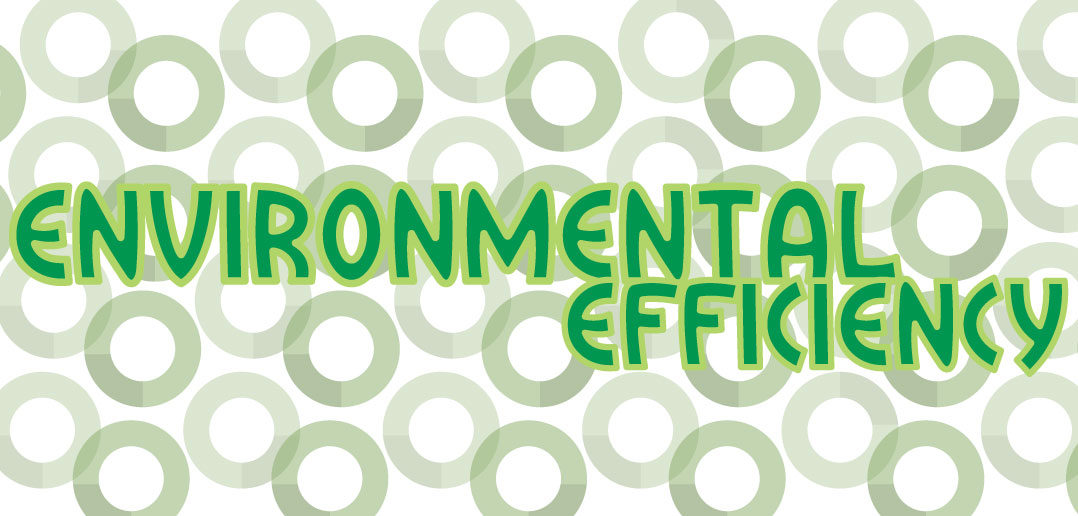Most often with beneficial applications for both residential and commercial users, the technology that’s available today has certainly come a long way in the area of promoting environmental efficiency. When it comes to improving a building’s environmental efficiency, whether you’re a homeowner or operating a business, there’s a lot you can do that will have a positive impact on both a personal and global level. Also commonly interchangeable with eco-efficiency, the driving principle is to generate more value through technology and process changes while reducing resource use and environmental impact throughout the product or service’s life. As this is a fairly broad topic to cover, we’ve narrowed it down and highlighted some of the best ways you could currently invest in the improvement of your home or business’s environmental efficiency.
Controlling your home or building’s systems is a key factor that will dramatically improve its overall environmental efficiency. Today, energy use is becoming an ever-increasing financial concern for commercial building owners and homeowners alike. Most are now actively seeking reliable, cost-effective solutions to answer these new energy challenges and manage overall energy cost.
“Engineered Controls can play a very big part in assisting new and existing building owners in controlling their building’s energy costs,” advises Pat Killeen, owner of Engineered Controls. “When considering that a building’s lighting and HVAC loads accounts for nearly 80% of its energy usage, there are plenty of energy strategies that a Building Automation System (BAS) can provide to maximize the options available to building owners. Engineered Controls can assist in total building control and help provide a healthier and more energy efficient environment for occupants.
Today more than ever, building owners want their facilities to be environmentally responsible and healthy places to live and work. They also want to optimize the energy usage, without compromising comfort. Together a tall order to accomplish, but at Engineered Controls that technology is available today. Furthermore, we partner with Honeywell, a major energy products company that is spending sizable research and development funds on developing new products that will improve our lives and reduce energy.
To help our customers in identifying efficiency areas in their buildings, Engineered Controls, in conjunction with Honeywell Inc., developed an Energy & Environmental Optimization (EEO) program to address these concerns of building owners to improve the environmental efficiency of their facilities. Our EEO (program) is designed to leverage a broad portfolio of energy efficiency products and solutions, as well as offer a high level of energy expertise to commercial buildings in the hands of our skilled, knowledgeable and certified EEO professionals. Our EEO team can help building owners and managers obtain real-world data to help them make fact-based decisions about how to optimize their buildings for occupants comfort and save energy at the same time.
It’s important to consider not only the investment in updated equipment and technology, but also what will need to be done to keep it running as efficiently as possible. Engineered Controls offers our customers Planned Service Agreements (or simply PSA’s) to assist our clients in the daily operation of their facilities. The PSA that has two elements:
1. Preventative care and routine maintenance; and 2. System-wide energy analysis.
Our preventative care program focuses on the building hardware and is a standardized preventative maintenance program on a building’s environmental controls system to maximize the system’s reliability and to minimize the operational costs. In other words, our PSA program offers comprehensive system-wide checkups and testing to ensure that the control system is always functioning at peak operating performance. Building systems that are properly maintained and controlled will enable you to focus on the core of your business while ensuring that everything is running efficiently. This also promotes longevity of equipment, protection of employees and equipment due to proper security measures, and energy efficiency which will result in minimizing operating costs and future unplanned capital expenditures.
In the second element of our Planned Service Agreement program, the system-wide energy analysis, our staff of trained experts will assist a building owner in identifying areas where they can reduce cost, identify simple potential energy savings payback opportunities and training. When our customers are interested in a more aggressive approach to energy reduction, then we move them into our EEO program that was previously mentioned.”
“As far as what’s on the horizon, indoor air quality (IAQ) is a major area that companies like Engineered Controls are looking into,” Killeen further explains. “A building with poor IAQ can have a very negative adverse effect on employees, customers and tenants because it can impact the health, comfort, well-being, and productivity of the building occupants. Having suitable indoor air quality in commercial buildings is an important component to the overall health of its occupants.
Today in commercial buildings, building technology companies like Engineered Controls can provide building owners and managers with sophisticated building automation systems that will monitor a building’s indoor environment to look for possible contaminates. The building automation system can also monitor human exposure to pollutants (e.g. carbon dioxide, carbon monoxide, radon, VOCs – volatile organic compounds and more) that can have an adverse effect on a worker’s health condition. As example, high levels of carbon Dioxide (CO2) can cause drowsiness and create an inefficient work environment for building occupants, whereas other toxic gases like carbon monoxide (CO) can have a potentially fatal affect for workers if not treated quickly. Engineered Controls offers a Demand Control Ventilation software program that will automatically adjust an HVAC system to introduce higher levels of outdoor air only when occupancy levels of building contaminants are at a high level. Equally important is that features like demand control ventilation only induce more outdoor air when required, thus allowing building owners to maintain optimum levels of IAQ and at the same time obtain substantial energy cost savings while increasing the comfort and productivity of employees or tenants.
Killeen adds, “In order to obtain a buildings maximum energy and environmental efficiency, the selection of building control equipment is more important than ever before. Today this is accomplished by selecting control equipment with open protocol communications capability. This allows intelligent building networks to be connected together in order to monitor and control all aspects of a building’s heating and cooling system and beyond.”
In terms of energy usage, conservation is key. In addition to major systems such as heating and cooling, even something as simple as lighting can have a major impact as it’s another fundamental part of our daily lives. “Today’s innovative buildings are designed to be sustainable, flexible and energy efficient,” explains Doug Seaman, Project Support Specialist at Echo Systems. Lutron is a technology-centered company and one of our primary vendor partners when it comes to energy solutions. You’ve probably heard the term LEED certification before, Leadership in Energy and Environmental Design (LEED) is a rating system the United States Green Building Council (USGBC) administers to provide a national standard for what constitutes a green building. LEED offers scientific performance criteria and a point system for LEED project certification. Many businesses have programs to ensure all of their facilities are LEED compliant, through new construction and renovation programs. Lutron offers leading edge product solutions for integrated control of electric lighting and daylight, and unsurpassed project support. They specialize in the area of lighting control and automated shades.
As one example, outfitting your project with lighting controls will help to reduce the negative environmental effects associated with excessive energy usage. Using lighting control can conserve 60% or more in lighting energy and 20% or more in HVAC energy.
Lutron systems provide many energy-saving strategies. To garner the maximum points this category provides, Lutron controls are critical.
Lutron solutions include: Dimming and switching systems | Integration of controllable window treatments |Astronomical timeclock scheduling | “Tune-to-task” management of high-end light levels | Daylight harvesting | Occupancy sensors
No matter where they’re installed or how big the system, every Lutron product saves energy by reducing electrical consumption. Taken as a whole, Lutron light controls have reduced electrical use by 9.2 billion kWh, which reduces its customers’ electric bills by $1 billion annually.
Lutron also protects the environment by decreasing the demand for light bulbs. Since dimmers extend lamp life, customers have to buy fewer bulbs, and that reduces the energy and environmental impacts associated with the manufacturing of fluorescent, incandescent, halogen, and other types of lamps.”
Seaman adds, “It is important to understand how energy codes play a key role in helping us reduce our energy consumption. They set the mandatory requirements for new building construction and major renovations.
The nation’s top three building energy codes and standards—Part 6 of Title 24 of the California Code of Regulations, the International Energy Conservation Code (IECC), and ANSI/ASHRAE/IES Standard 90.1—are used by nearly every U.S. state as the basis for local building energy codes. These codes and standards reflect the importance of using lighting controls to conserve energy. In fact, they all have very similar mandatory lighting control requirements that designers and engineers must meet for new construction and major renovation projects.
Use this tool to see what the commercial building lighting control requirements are for Nebraska and Iowa and Lutron solutions to help meet them. (http://www.lutron.com/en-US/Education-Training/Pages/EnergyCodes/StateEnergyCodes/EnergyCodes.aspx)
Additionally, there are rebates and incentives that encourage businesses to save energy through energy efficient products and the proper use of these products. It is well worth looking into and an industry expert will be able to direct you to what is most beneficial for your business.”
Heating and cooling systems are a prime example of how you could utilize a renewable energy source to power a major aspect of your building in terms of energy usage.
“Geothermal heating and cooling is considered the world’s greenest and most energy efficient way to heat and cool your home, office or business,” further emphasizes Troy Spady of Complete Comfort Omaha. “It eliminates the need to use propane and natural gas, it is more efficient and cost-effective compared with conventional residential systems, and geothermal energy can be found underground virtually anywhere. The Waterfurnace systems we use emit no carbon dioxide, carbon monoxide or other greenhouse gasses. They are truly a natural, green heat pump.
In addition to being environmentally friendly, the tax benefit for installing geothermal heating and cooling is fantastic for home and commercial building owners. The Energy Improvement and Extension Act of 2008 offers a one-time tax credit of 30% of the total investment for homeowners who install residential ground loop or ground water geothermal heat pumps. A credit of 10% of the total investment is also available for a commercial system installation. This legislation is good for installations placed into service from January 1, 2009 through December 31st, 2016. In some situations, the cost of installing a geothermal system ends up being close to the same price as a traditional heating and cooling system! How many times does a person get to be environmentally conscious and budget conscious at the same time?”
He adds, “In this day of rising energy costs and more and more talk of being environmentally conscious, it’s vital that we begin to look at alternative energy sources. Especially one such as the ground that is 100% renewable and not going anywhere! The benefits are countless from a smaller carbon footprint to putting money back in your pocket year to year. Geothermal energy is not only the future; it’s the present and is growing by the day!”
Each of us has the ability to make a positive impact on our environment and it starts with the commitment to be aware of the part that we play and to make a change wherever and whenever necessary. The best part? You just have to take the first step by reaching out to evaluate your options and the local experts who are at the cutting edge of industry trends and technology advances will follow through with the rest!




